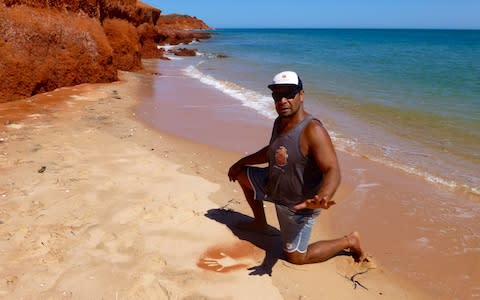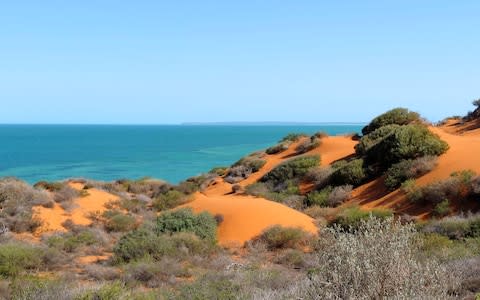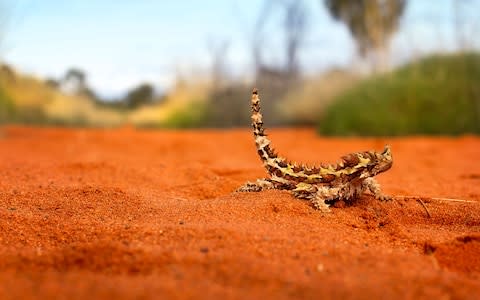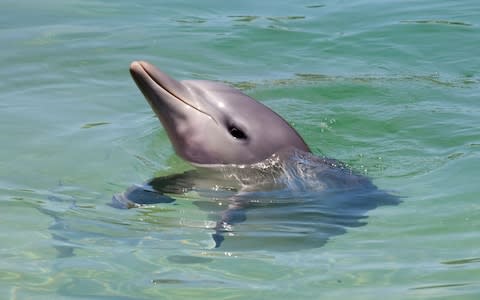Exploring the Australian coastal wilderness where Blue Planet II was filmed
![Shark Bay is one of Australia's most striking landscapes - (C) Pierrick Limousin ((C) Pierrick Limousin (Photographer) - [None]](https://s.yimg.com/ny/api/res/1.2/ymrJ3u3Grv4e4IFIlUErCw--/YXBwaWQ9aGlnaGxhbmRlcjt3PTEyNDI7aD03Nzc-/https://media.zenfs.com/en-GB/the_telegraph_818/d1fe3652ed730bdc0e8e7353810352e1)
We stop at the “drive-through” Bottlemart in Denham to pick up beer, then head off through the dusk with live commentary from an Aussie Rules football game in faraway Fremantle on the radio. “Moon’ll be coming up over there in a minute, brother,” says my companion, Dean Capewell (“Capes”), pointing across low scrubland to the east. When the moon does appear it is full-faced and wearing a bandanna of cloud.
By the old sheep station, where the windmill still spins in the breeze, the sandy track turns sloppy. To improve traction we stop to let air out of the Land Cruiser’s tyres, using twigs from the ubiquitous wattle tree to depress the valves. A little further on, Capes brakes hard and reverses, jumps from the cab and wrestles a limb from a bush.
“Medicine tree,” he says. “Thumbuny. You only take a dead piece, never a green. It’s like family, that tree.” Later, when the fire we have made on the beach is crackling, Capes heats the end of the dead thumbuny branch in the flames until it glows, then plants it in the sand so it burns away like a joss stick, emanating a fragrance that smells dreamily familiar. Sniffing and frowning, I finally make the connection: thumbuny is sandalwood.
This is a story about connections: between people and land, between desert and ocean, between this visitor to Australia and the Indigenous man, whose country it has been for 20,000 years. Capes, who is 48, lives in Shark Bay, a sparsely populated region of the Indian Ocean coast at Australia’s most westerly point, a couple of hours’ flying time north of Perth.
At its heart, two bony fingers of land thrust up into the ocean, fretted with bays and lagoons of blue-green waters and swaying seagrasses. These peninsulas are national parks – Dirk Hartog Island and François Péron, named after early European explorers. The dugongs and bottlenose dolphins that feature in Blue Planet II were filmed here and the whole area is on the Unesco World Heritage list due to its rich biodiversity and astonishing natural beauty (the colours of red sand and white sand, of lime-cordial shallows and indigo depths, belong to Gauguin in his Tahitian period).

From his base in the old pearling settlement of Denham (“Don’t blink, mate – you’ll miss it”), Capes runs a variety of tours into this glorious wilderness that draw on his deep knowledge of, and connection with, “country” – the ancestral land that is in his heart as well as beneath his feet.
I am privileged to spend a day-and-a-half with him, driving up into the 203 square miles (526 sq km) of the François Péron National Park to explore the coastline by kayak, camp on the beach and walk the red sandstone cliffs in pleasant late summer temperatures topping 80F (27C). His raison d’être, he says, is “about bringing people like you and getting you to feel it, not just see it.”
The morning after camping on the beach – no human presence for miles, just a white-bellied sea eagle keeping an eye on us from its perch nearby – we roll up our swags and rake sand over the fire with our feet. Then Capes leads me to an ancient shell midden cupped in the dunes. He has mixed parentage from the two principal Aboriginal groups of the region, the Malgana and the Nhanda. As we enter the midden he talks rapidly in Malgana – “Announcing ourselves, saying hello to the country,” he explains.
He points out a sheer-sided rock in the middle of the hollow, amid the scattered seashells. “We’ve got our grindstone, see? This is where our ancestors would have come and camped, dug for fresh water. You come back for thousands of years, you build up these deposits of shells.” I ask him what he feels, standing here with old and familiar ghosts. “Well, you don’t feel you’re alone, put it that way.”

The first Europeans to make landfall here were French explorers (among them François Péron) in 1801 – a mere blink of an eye ago in Aboriginal time. “We showed those people where to find food and water, medicine,” says Capes. In return, and somewhat inevitably, the French took precious artefacts that the Aboriginal community is now trying to claim back.
As we’d sat around the camp fire the night before, Capes had talked of the serial injustices that the indigenous people of Australia have suffered, and continue to suffer, since the arrival of the Europeans, and the struggle to maintain their culture in the face of concerted attempts to eradicate it. “Tourism is a vehicle for teaching people,” he had concluded. “You only get respect through education and understanding.”
There is precious little understanding when, shortly after visiting the shell midden, we run into a European who says he lives locally. Capes is showing me the versatile kurara tree, a small acacia with needle-like leaves that may be used to cure warts and lower blood pressure, while the branches make good kangaroo spears. Overhearing us, the man walks over. “You don’t really believe in all that stuff do you?” he says to Capes with an incredulous smirk on his face.

Capes responds with gentle courtesy. This ignorant man is no different from his early 19th-century ancestors who gazed on Shark Bay and saw nothing but hardship and danger. For Capes the bush is everything. “We eat tubers, leaves, flowers and berries, raw or cooked,” he says. “This is the meat and veg section of the supermarket. The ocean is the fish counter.”
Back on the beach he shows me a hole freshly dug by a kangaroo. It is feet away from the ocean, but the water in the bottom is drinkable. “We say nature talks and you must listen to it,” he says. “If you want fresh water, follow the kangaroos. This is just one way nature can talk.”
The Aboriginal people of coastal Western Australia are “salt water people” who have made their living by the sea and, in their dreaming stories (or creation myths), find final rest out there in the ocean. Shark Bay is an auspicious place for them, a crossroads.

Not only is it where the tropical northern climate meets the temperate south (with plants of both zones coexisting). It is also where the desert – the same red sandstone that covers Uluru, “Australia’s belly button,” almost 1,500 miles (2,386km) due east – joins the salt water in the west. Before it does so, it meets and marries the white limestone sand of the beaches. There is a harmony and balance here that feels tangible.
Our kayak trip along a twisting inlet known as the Big Lagoon offers the perfect means of channelling that balance. While Capes does the hard work in the back of our two-man boat (“Take a rest brother, put the cue in the rack,” he says), I watch small reef sharks skitter away from the hull and pied cormorants bunching protectively on the red-and-white shoreline.
On one of the many deserted beaches, we land the kayak and wander the dunes, the sand as hot as a griddle, though Capes’s bare feet are inured to it. Fragments of mother-of-pearl, glinting in the high sun, indicate the site of a pearling camp from the 19th century. Above the dune ridge, a wedge-tailed eagle hangs near-motionless, riding the thermals. Capes seems, for once, lost for words. Then he says: “I’m recharging, brother. Plugging back into the power socket.”
It is on this beach that he gives a beautiful demonstration of our (I’m meaning humans here) connection to country and history. Here the red sand is the deep red of dried blood. Capes scoops a handful, kneels on the white sand above the lapping waves and sprinkles the fine red grains around his splayed fingers. When he lifts his fingers he reveals a hand stencil that looks like rock art, but will last a few hours at most. “It’s temporary, not permanent,” he says. “Just like us.”
Essentials
Wula Guda Nyinda (wulaguda.com.au), which translates as, “You, come this way,” is Dean Capewell’s eco-adventure company, offering various tours in Shark Bay: the two-day/one-night François Péron Catch & Cook Safari costs AU$485 (about £265) for adults, AU$420 (£230) for children.

Getting there
Rex Regional Express (rex.com.au) flies between Perth and Shark Bay/Monkey Mia: returns from around AU$700 (£380). Nigel Richardson flew on the Qantas (qantas.com) non-stop flight from London Heathrow to Perth (17 hrs, from £900 return).
Where to stay
Monkey Mia Dolphin Resort (parksandresorts.rac.com.au/park/monkey-mia), on the edge of François Péron National Park, has beach-view rooms from AU$280 (£153) a night. Also see the websites below, under “More information”.
When to go
Year-round except for high summer (Dec-March) when temperatures can reach 105F (40C) or more.


